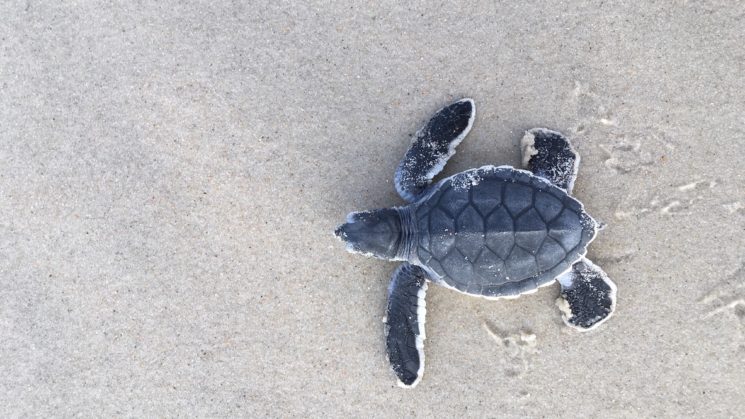
Above: A green sea turtle hatchling, courtesy of Matthew Godfrey, N.C. Wildlife Resources Commission.
Sea turtles came ashore in record numbers to nest on North Carolina’s beaches this year. Volunteers and researchers recorded over 2,200 loggerhead nests along the coast by mid-August, breaking the 2016 record of 1,622 nests.
“We’re not entirely sure why this is such a big year, but perhaps it reflects the protections enacted a few decades ago, to protect nesting females and their incubating eggs on our beaches,” says Matthew Godfrey, a sea turtle biologist with the NC Wildlife Resources Commission.
He adds that South Carolina and Georgia also are experiencing record loggerhead numbers this year.
At Cape Hatteras National Seashore, the 2019 season is the third in the past five years for record nest numbers within the park. As of earlier this week, they already had 428 loggerhead nests, 24 green sea turtle nests, and 1 Kemp’s Ridley nest. Loggerheads and green sea turtles are two of the species that most commonly nest in North Carolina.
“Typically, a female will come up onto the beach at night, and use her back flippers to dig a nest. Once the nest is dug, the female lays her eggs and then she covers it back up and returns to the ocean,” explains Dia Hitt, education curator with the North Carolina Aquarium on Roanoke Island. “Each nest contains 100 to 120 eggs, with hatching starting in July and going as late as October.”
Volunteer groups, such as the Ocean Isle Sea Turtle Protection Organization, help to protect eggs, hatchlings and nesting mothers. Deb Allen, island coordinator for the group, says that everyone can help to protect sea turtles.
“We encourage everyone to practice Lights Out — Sea Turtles Dig the Dark from May to September. Please turn off all lights that can be seen from or on the beach. If you can see it, a sea turtle can see it.”
Allen explains that artificial lights can disorient the turtles, leading them away from the ocean and toward the light source.
Godfrey, Hitt and Allen share the following tips for how beachgoers and coastal residents can help protect sea turtles:
Find a sea turtle group near you on this page, and zoom in on the map to find N.C. locations or to check out other beaches you may visit.
To see nesting data, visit the North Carolina Wildlife Resources Commission’s Sea Turtle Monitoring System page.